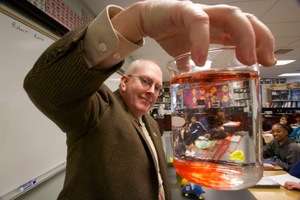Andrews chair funded by creative source

Michael Morgan is busy right now. On top of teaching high school chemistry, he’s coaching, and it’s “right in the middle of the academic season.” His teams compete in the Science Bowl, the Chemistry Olympiad, and the National Ocean Sciences Bowl.
He takes a short break to speak with exuberance about a subject close to his heart: Frank Andrews, the recently retired chemistry professor who changed his life. Morgan has just completed the paperwork for a donation that will endow a chair at UC Santa Cruz in Andrews’ name. The chair will support a UC Santa Cruz professor who teaches how to teach science.
“I want to make a lot of copies of me,” says Morgan (Crown ‘88, chemistry).
He describes his vision like the effort to land astronauts on the moon. He hopes the chair becomes part of a nationwide push to inspire talented, enthusiastic young people to go into teaching.
Making a difference with middle-class philanthropy
Morgan doesn’t have enough money to endow a chair right now, but he and his wife, Maria, own a house.
“My wife and I don’t have any kids, or I say I get 150 new ones every year,” Morgan jokes.
They came up with a creative way to fund the chair: when they die, UC Santa Cruz will use their house to fund an endowment. By establishing the bequest now, the Morgans can honor Andrews while he’s alive. And they hope some of the other UC Santa Cruz grads who have been influenced by him will also establish bequests or think of other creative ways to raise the $1 million needed to endow the Andrews chair sooner.
The chair is modeled on Frank Andrews’ approach to teaching chemistry, which he did for nearly 40 years. He wrote a widely used chemistry textbook as well as a groundbreaking self-help book titled The Art and Practice of Loving. And he inspired many, Morgan among them, to become teachers.
Andrews says he was moved when Morgan told him his plan.
“It’s a noble intent,” he says. “I like the idea of supporting somebody who has this vision. I think it’s an incredible idea.”
Innovating science teaching
Andrews’ classes included fewer lectures and more small discussion sections. And the sections were led by undergraduate students of another of Andrews’ classes, Teaching Science in the University.
“I was dissatisfied with the way sciences are taught. One fact after another after another. I don’t think we were teaching them well,” he says. “These big, amorphous lecture courses. It’s like they take the spirit out of the subject.”
The small sections meant students were constantly explaining to one another what they were learning. “And it worked. Man, it worked,” he says.
From aspiring sailor to chem teacher
Morgan met Andrews the first day of classes in 1984. Morgan had chosen UC Santa Cruz hoping to join the sailing team—he had Olympic aspirations. A few minutes with Andrews completely changed his priorities.
In contrast with the other professors he had, Andrews didn’t give a lecture designed for note-taking, and he didn’t try to scare his students with warnings about how many people fail out of school. Instead he welcomed the room full of nervous first-year students. He made it clear that he and the Teaching Science students were invested in the new students’ success.
“Frank knew more about how to reach a student than anyone around. I wanted to be that teacher,” Morgan says.
He would eventually join the Teaching Science class himself. Now he’s been a high school science teacher for nearly three decades.
He’s not the only one. Another former Teaching Science student, Ken Wagman (Stevenson ’78, Mathematics), counted off several of his classmates who became teachers.
“It allowed students who were advanced to teach,” he says. “And they developed that love of teaching.”
Which is why the chair to be established in the name of this professor of chemistry will focus on teaching.